 |
Focus features two in-depth reviews each month of fine art, architecture and design exhibitions and events at art museums, galleries and alternative spaces around Japan. The contributors are non-Japanese residents of Japan. |
|
|
 |
 |
 |
Musée Tomo: Madame Kikuchi's Legacy Lives On
Lucy Birmingham |
 |
Tatsusuke Kuriki (1943-2013), Walking Circle (1976), H44.5 x W54.0 x D40.0 cm. Courtesy of Musée Tomo |
|
Mineo Okabe (1919-90), Ash Glazed Bottle (c.1963), H36.0 x ∅23.8 cm.
Courtesy of Musée Tomo |
Legendary ceramics patron Tomo Kikuchi (1923-2016) passed away last summer at the ripe age of 93, but her impactful legacy lives on. Not just in the hearts of her many admirers and the artists she supported, but in exhibitions of her remarkable collection of nearly 1,000 contemporary ceramic works and an untold number of paintings and antiques.
A memorial exhibition featuring pieces from her contemporary ceramics collection is now showing until 3 September in Tokyo at Musée Tomo, the museum she founded in 2003. The 61 works on display reveal her unique eye for beauty, found in a wide choice of styles by artists ranging from famous to up-and-coming.
Among the many standouts: a white porcelain box by Kenkichi Tomimoto, known more for his Mingei-inspired works; the goosebump-inducing Bible of Sand by Takako Araki; Walking Circle by Tatsusuke Kuriki; celadon-glazed works by Koheiji Miura and Shinobu Kawase; a mask by Mokichi Otsuka; the Hagi-ware High Heel by Kyusetsu Miwa XII; Seimei Tsuji's Can series in porcelain and Shigaraki ware; Mineo Okabe's Ash Glazed Bottle; and a vase and container by Kanjiro Kawai.
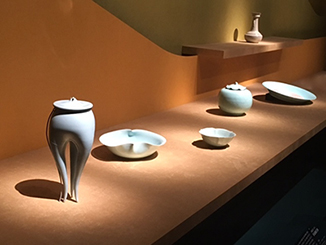 |
|
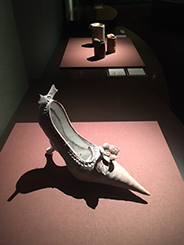 |
|
Left to right: Shinobu Kawase (1950-), Lidded Incense Burner with Celadon Glaze (1990), H41.0 x ∅17.0 cm; Large Plate with Celadon Glaze (2011), H10.4 x W34.4 x D30.7 cm; Lobed Bowl with Celadon Glaze (1970), H5.3 x ∅21.0 cm. Koheiji Miura (1953-2006), Celadon-Glazed Jar with Lid, with a Knob in the Form of a Donkey Cart (1982), H23.8 x ∅25.6 cm; Celadon-Glazed Plate with Overglaze Enamels Depicting a Scene and Figures from Rajasthan, India (1985), H6.5 x ∅46.0 cm. Photo by Lucy Birmingham |
|
Foreground: Kyusetsu Miwa XII (1940-), High Heel (1979), H22.2 x W31.3 x D10.2 cm. Background: Seimei Tsuji (1927-2008), Can, Shigaraki Ware (1982), H13.5 x ∅9.8 cm; Can, Shigaraki Ware (1982), H12.8 x ∅8.5 cm; Can, Porcelain (1982), H17.0 x ∅13.5 cm. Photo by Lucy Birmingham |
Madame Kikuchi began her collection in the 1950s, but it wasn't until 1979 that she exhibited Japanese contemporary ceramics abroad. The show turned out to be a huge hit. Displayed at her temporary boutique in Bloomingdale's department store in New York City, her entire inventory of bowls and plateware quickly sold out.
Her 1983 Japanese Ceramics Today exhibition at the Smithsonian Institution in Washington, D.C. followed to great acclaim. "About one million people came to see the unique works," says her daughter and Musée Tomo director Misao Kikuchi. The show featured about 300 pieces from her mother's modern and contemporary collection, most of them by young ceramic artists.
The show then traveled to the Victoria and Albert Museum in London. "They were breakthrough exhibitions and greatly impacted American and European ceramic lovers," says Misao. "Previously, modern Japanese ceramics were known abroad as craftwork."
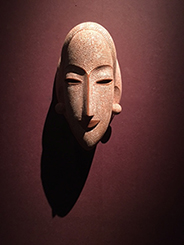 |
|
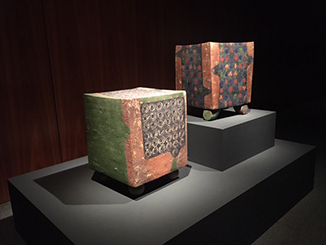 |
|
Mokichi Otsuka (1956-), Mask (2005), H25.4 x W17.4 x D17.8 cm. Photo by Lucy Birmingham |
|
Tamei Morino (1934-), (left) Joker's Chair (1991), H35.1 x W28.7 x D28.8 cm; (right) Queen's Chair (1991), H35.2 x W28.1 x D27.5 cm. Photo by Lucy Birmingham |
It was Misao's maternal grandfather who got her mother interested in art. A powerful industrialist, he was also an art enthusiast, but never accumulated a collection of his own.
Her mother's first encounter with ceramics came during World War II when she watched one of her father's workers throw a clay pot on a pottery wheel. She was struck by the beauty and vitality it emanated. "During those war years my mother was surrounded by death. She had lost friends and family members," says Misao. "The life of the clay made a deep impression on her."
As a young woman, her mother also studied the traditional Japanese tea ceremony, or chanoyu, with its antique ceramic bowls and utensils. "Coming from a wealthy family, she was able to actually see and use these valuable antiques," says Misao. "But she preferred contemporary ceramic pieces because she could take part in the creative process."
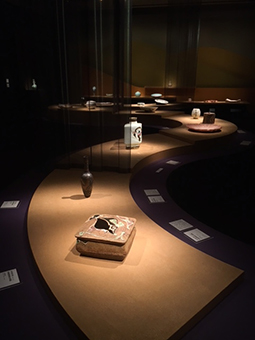 |
|
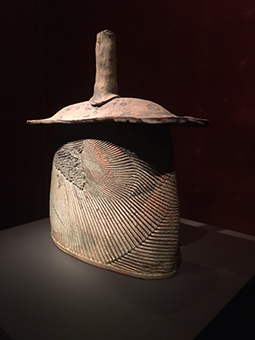 |
|
Kanjiro Kawai (1890-1966), (foreground) Ash-Glazed Container with Slip Design of a Fish (c.1950), H14.3 x W25.4 x D25.4 cm; (center) Vase with Floral Design (1959), H34.1 x W31.1 x D22.4 cm. Photo by Lucy Birmingham |
|
Kinpei Nakamura (1935-), Shouldered Jar (1980), H48.0 x W44.5 x D17.0 cm. Photo by Lucy Birmingham |
Musée Tomo is built on the family's land next to the famed Hotel Okura and offers a quiet, relaxing oasis with a private garden bordered by Japanese maple trees that turn a breathtaking red in autumn. Visitors can enjoy the view from a café fitted with floor-to-ceiling glass windows.
Also on the property is Seiyokan, a western-style wooden structure built in the 1920s that is now a registered cultural property. Misao's grandfather used the building as an office and living quarters after purchasing it from a tobacco magnate. The land is located on the crest of a steep slope called Edomizaka that once offered sweeping views of Edo (now Tokyo). In medieval times it was home to a castle.
In contrast, Musée Tomo's structure is modern, but also contains dramatic elements. Walk down the long entry hall and you see at the end an eye-catching mural by her mother's long-time friend, the calligraphy and sumi-e icon Toko Shinoda. Another Shinoda work with silver tones is painted on the wall that leads down to the subterranean galleries. Glass artist Naoto Yokoyama designed the striking glass bannister.
Works are displayed without glass cases and are expertly illuminated. Colors and shadows are highlighted with dramatic spotlighting.
 |
|
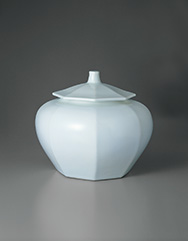 |
|
Takako Araki (1921-2004), Bible of Sand (1981), H14.0 x W60.0 x D45.0 cm. Photo by Lucy Birmingham |
|
Kenkichi Tomimoto (1886-1963), White Porcelain Octagonal Covered Box (1932), H21.5 x ∅24.5 cm. Courtesy of Musée Tomo |
Musée Tomo plays a significant role in supporting contemporary ceramic artists. The Kikuchi Biennale is one example. Launched in 2004, it showcases a range of talents from young to old, including non-Japanese.
During alternating years the museum sponsors the Kikuchi Kanjitsu Prize for contemporary Japanese crafts by living artists. Ceramic, glass, metal, and textile works, as well as dolls and other items, are nominated and exhibited.
Madame Kikuchi also fortified her philanthropic support through her Kandori Gallery at the New Otani Hotel in Tokyo. Opened in 1974, it continues to serve as a launching platform and sales venue for countless numbers of contemporary ceramic artists.
"There's little art philanthropy in Japan these days," says Misao. "We need more collectors like my mother." Madame Kikuchi's efforts to attract interest in Japanese contemporary ceramics abroad are bearing fruit today. "Museums in the United States and elsewhere are now collecting these works," explains Misao. "We want to continue to encourage and support talented young artists."
All images are shown by permission of Musée Tomo.
|
 |
 |
Lucy Birmingham
Lucy Birmingham is a long-time, Tokyo-based journalist, scriptwriter, author, and former photojournalist. She recently served two years as president of the Foreign Correspondents' Club of Japan. She has written regularly for TIME magazine and her articles have appeared in many publications, including the Wall Street Journal, Newsweek, Bloomberg News, and Architectural Digest. As an arts and culture writer her articles have appeared in publications including Artinfo.com, Artforum.com, and ARTnews. She is also a scriptwriter and narrator for NHK (Japan's public broadcaster) and has published several books including Strong in the Rain: Surviving Japan's Earthquake, Tsunami, and Fukushima Nuclear Disaster. lucybirmingham.com |
|
 |
|